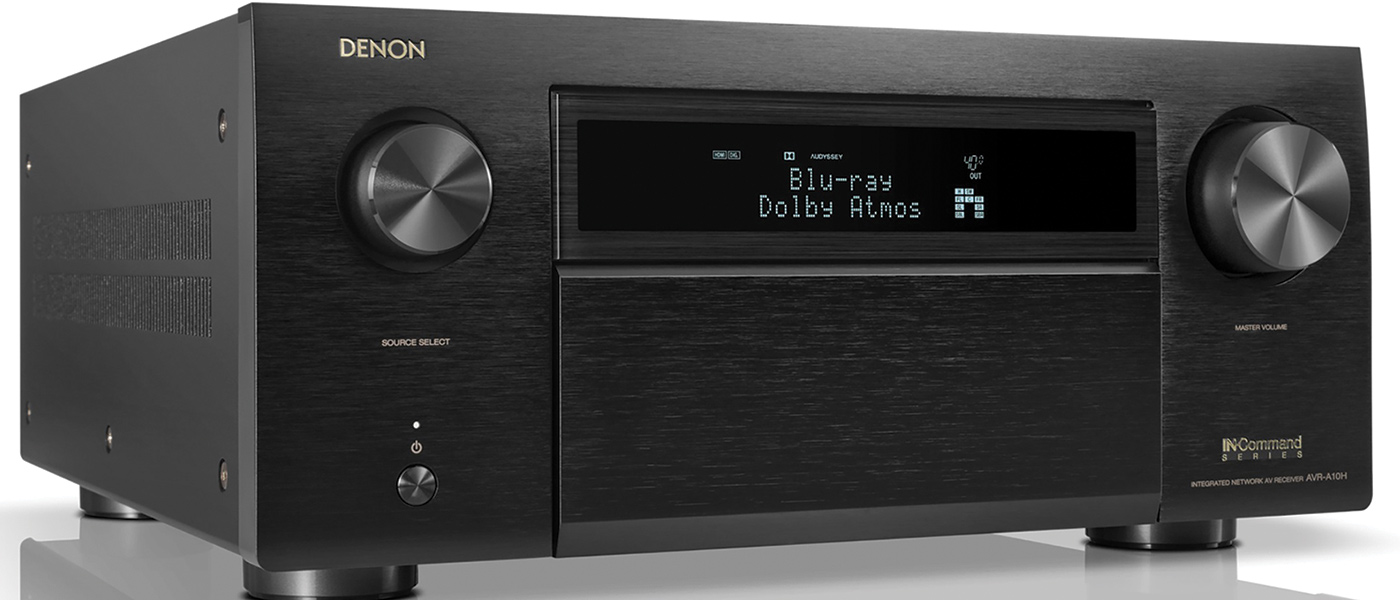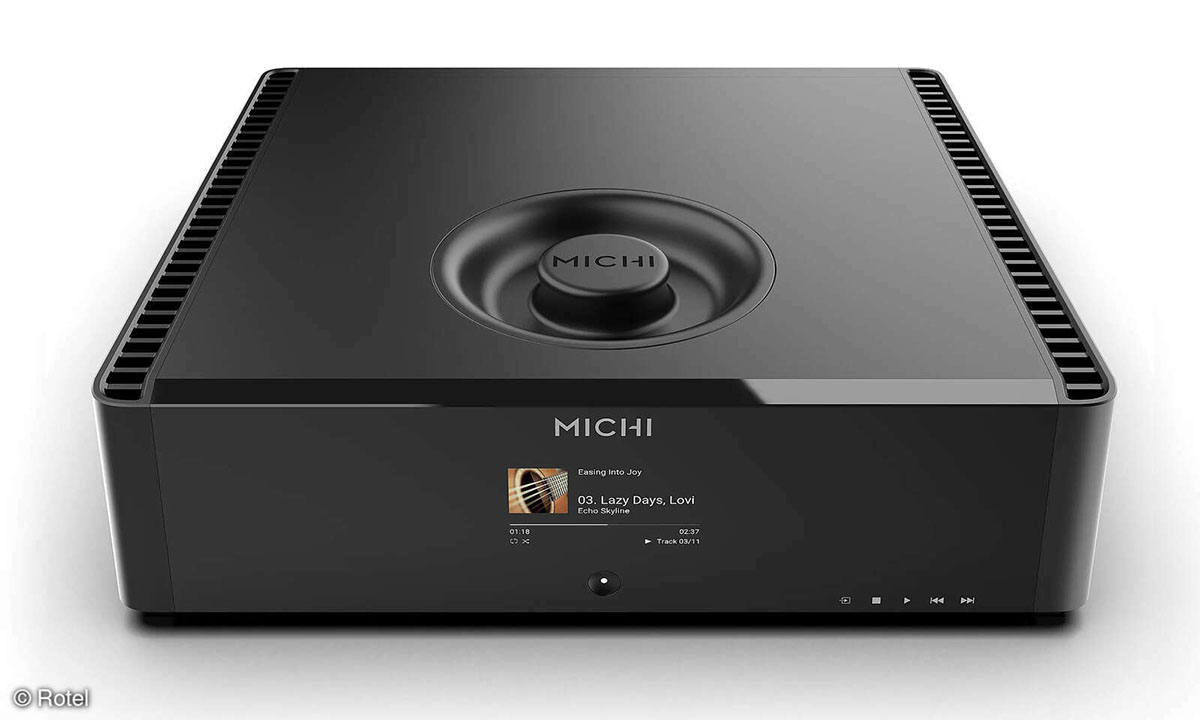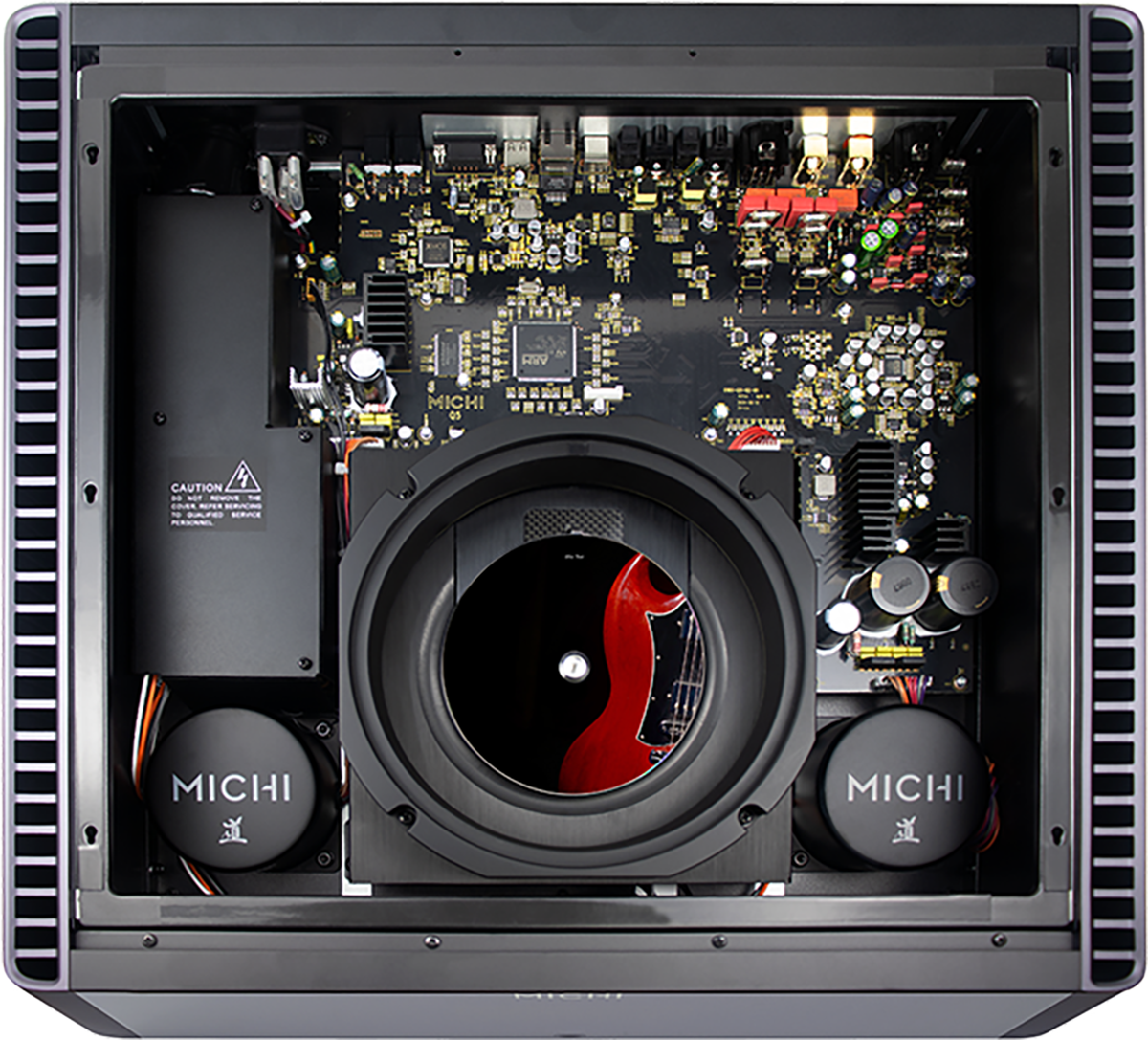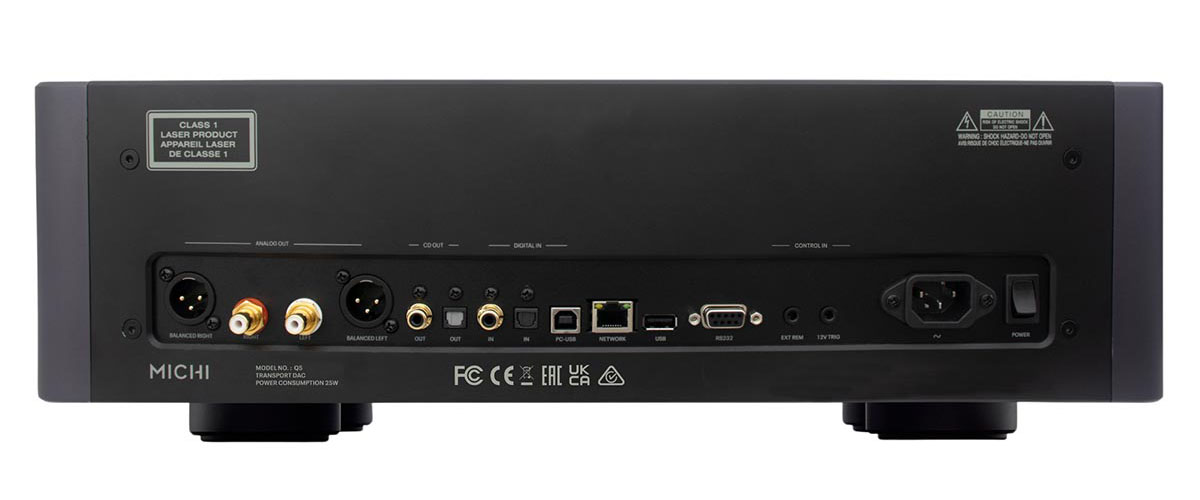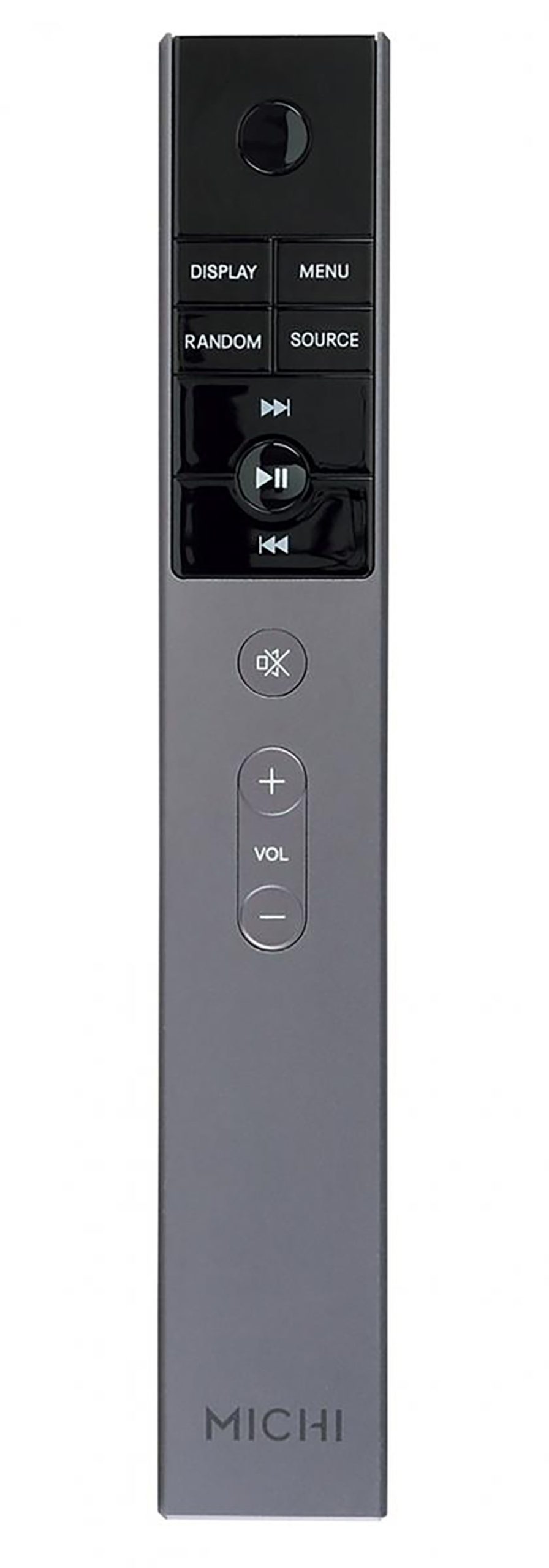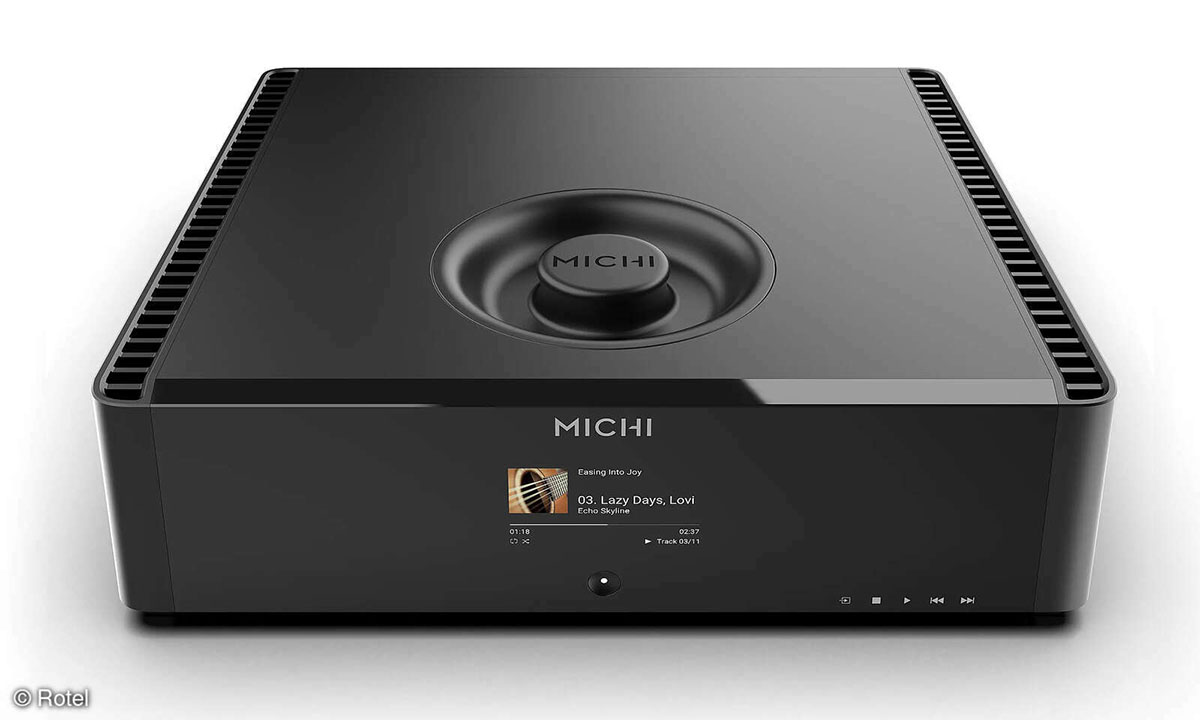It might be the last audio source component you ever buy.
Founded by Tomoki Tachikawa in 1961, Michi’s parent company, Rotel, is best known as an engineering company that makes fine audio components. They are still a family-owned business that receives a lot of respect from recording engineers, musicians, and audiophiles worldwide.
Rotel’s Michi line is renowned for building exceptionally high-quality audio products that tend to weigh more than other products in their price and performance range. This comes from their dedication to quality, for which they have received rave reviews since re-introducing the Michi line a few years ago. They have a 51-pound pre-amp in the P5 (and P5 Series 2), a 132-pound stereo power amp in the S5 (or one can opt for two 132-pound mono versions in the M8), along with a pair of stout integrated amplifiers. The Q5 DAC / Transport continues that tradition with its 52-pound weight. Michi doesn’t design products with a weight goal in mind. What Michi does is design a product to meet its engineering specs, regardless of the weight. It’s no accident that their components have so much gravity built into their chassis. Let’s explore together what all this mass means to real-world sound reproduction.
Michi Q5 DAC / CD Transport
- Top-loading CD mechanism.
- 52 pounds of pure Michi engineering.
- Dual in-house manufactured toroidal transformers.
- MQA compatible.
- 24-bit / 192kHz coaxial and optical inputs.
- World-class DAC as a stand-alone audio component.
- PC-USB Input (up to 32-bit / 384kHz).
- CNC-machined aluminum chassis.
- CD transport custom floating spring assembly.
- TFT display that showcases CD album artwork.
- XLR and RCA analog outputs.
- Optical Toslink and Coaxial CD digital outputs
- High-end look that focuses on quality.
The word ‘Michi’ translates into ‘road’ or ‘path.’ In the early 1990s, Rotel introduced the Michi line as a ‘path’ towards exceptional audio performance without price as a consideration. Their rosewood cabinets and high-end sonics made Michi a household name in Japan for much of the 1990s. After a 20- year hiatus, Rotel re-introduced Michi in 2020 with the release of a stereo pre-amplifier (the P5), a stereo power amplifier (the S5), and a mono power amplifier (the M8), and soon followed with the X3 and X5 integrated amplifiers.
The products received universal acclaim for their audio prowess, with comparisons to components selling for 10 times the price often being cited. Unlike most of these statements, in which we are treated to mundane lines such as ‘can compete with amplifiers selling for five to ten times the price,’ Michi’s products were being directly compared to real-world products with names mentioned. In early 2021, when I joined Secrets as a staff writer, I wanted a reference-level pre-amplifier and power amplifier. After reading John Johnson’s excellent review of the X5 integrated amplifier in February 2021 (see review here), I pulled the trigger on a purchase of the Michi P5 pre-amplifier and S5 power amplifier. Four years later, both components (along with a McIntosh MC303 power amplifier) stand at the pinnacle of performance for testing loudspeakers.
There has been one major missing component within the Michi line: a proper CD player. If one wanted a CD player from the family, one had to go with the standard Rotel line. The Michi Q5 DAC / CD Transport gives the Michi buyer a look at a premium quality CD player that, while not cheap at $6,999, is an assault on the best CD player / DAC one can find regardless of the price.
Total Harmonic Distortion (THD) CD/Coaxial/Optical/PC-USB Input:
< 0.0006%
Frequency Response:
20 Hz – 20 kHz, +0 dB -0.1 dB / 10 Hz – 70 kHz, +0 dB, -3 dB
S/N Ratio (“A” Weighted):
>115 dB
Dynamic Range:
>99 dB
Digital to Analog Converters:
ESS ES9028PRO (32-bit/768 kHz DAC)
Channel Balance:
± 0.5 dB
Channel Separation:
>104 dB @ 10 kHz
Dimensions (W × H × D):
485 x 150 x 452mm / 19 x 6 x 17.75 in
Net Weight:
23.5 kg (51.8 lbs.)
MSRP:
$6,999
Website:
Company:
SECRETS Tags:
Rotel, Michi, Michi by Rotel, Q5, CD Transport, DAC
Secrets Sponsor
The Michi Q5 starts with a top-loading CD mechanism built from CNC aluminum with a clamping system that easily slides into place after resting the CD on the tray. This clamp gives one the first clue of the build quality of the Q5, as it alone weighs as much as a typical CD player today.
The Q5’s DAC is anchored by the ESS ES9028PRO Eight-Channel DAC. To ensure the sound quality meets the company’s standards, Michi dedicated four channels of this chip each to the Left and Right audio for optimal digital-to-analog conversion, delivering exceptional linearity with minimal distortion.
The Q5 features fully balanced circuitry and dual toroidal transformers to reduce noise and interference for noise and distortion-free CD audio playback. It further supports 32-bit/384 kHz PC-USB (rendering MQA and DSD 4x) and 24-bit/192 kHz optical and coaxial, which will make the Q5 more than a CD player: It can be the digital hub for all of one’s components, along with its role as an ultra-high-end CD player. The Q5 has both unbalanced RCA analog outputs and fully balanced differential XLR outputs. CD audio playback is also provided in native 16-bit/44.1 kHz to rear panel Toslink Optical and Coaxial outputs for ultimate installation flexibility. The Q5 is Roon tested and certified via the PC-USB connection.
The front panel features a full-color TFT display with CD album artwork that looks great while spinning a disc. It also adds to that high-end eye-candy visual appeal that great components are known for.
The Michi remote control, RS232, and Ethernet ports allow operation and integration with all popular automation systems, adding home system customization to its many virtues. One other feature of note is that the remote control from any of the three components we have here (Michi P5, Michi S5, and Michi Q5) will operate all three components.
When one lifts the Q5 out of its box, the quality is immediately apparent. It feels like a stout power amp. There is no flex in the chassis, and its weight lets one know it’s a serious component.
Michi claims all their products are designed for demanding audiophiles. Let’s find out how well the design team did with this new component.
The Michi Q5 DAC / CD Transport was shipped on a pallet to my Stellantis dealership in northwest Pennsylvania. When it arrived, my parts manager informed me that a new “power amp” had been delivered to the loading dock. I grabbed the Q5 and put it in the back of a new Wagoneer S (fully electric with a McIntosh Audio system) for the trip to our home and high-end listening room. The fun part, after the guys were impressed that the boss could handle a 75-pound oversized box by himself, was telling the crew, “It’s not a new amp – it’s a CD player.” The looks on their collective faces while trying to imagine a CD player that stout was amusing to see.
Once the Michi was in our home and unboxed, it was time to select a system. We ended up with the Michi Q5 CD Transport / DAC, Michi P5 pre-amplifier, McIntosh MC303 power amplifier, and the Diptyque Audio 140 Mark II planar speakers.
Cabling was Clarus Cable Aqua XLR balanced cables from the Q5 to the P5 and the P5 to the MC303. Speaker cables were Clarus Cable Aqua. Power was supplied through a Clarus Concerto power supply/conditioner, and power cables were Clarus Aqua cables for all three components.
From our 75-inch Samsung TV, a Toslink optical cable was connected to the optical cable input on the Michi Q5, allowing it to be used as a DAC. The Diptyque speakers were selected for their amazing ability to reproduce the finest of details within a recording, plus their powerful bass below 30 Hz. If there is a weak link in an audio chain, the Diptyque 140 Mark II’s will find it.
The setup was complete. For some references, over the last several years, a Yamaha CD-2100S has been our primary source for playback of CDs, which is still my go-to arena for the highest level of sound reproduction. I also recently finished testing on the Teac VRDS 701T CD transport feeding the UD-701N Pre-amp / DAC. Both are excellent digital sources, so the Michi had some big shoes to fill.
![[Study Of The Invisible] Vanessa Wagner](/wp-content/uploads/2015/06/figure-6-Michi-Q5-DAC-CD-Transport-Wagner.jpg)
Vanessa Wagner (Study of the Invisible) INFINE-Music CD
Classical pianist Vanessa Wagner elevates her interpretations of the minimalist genre by introducing the listener to individual performances from numerous rare or unpublished, but talented composers, young pianists, and raw individualists from a variety of music arenas. In her home country of France, Ms. Wagner is without doubt the only classical pianist to tackle what is both a contemporary and eclectic ensemble of songs. ‘Study of the Invisible’ features her rendition of pieces by a distinguished list of composers that includes Suzanne Ciani, Harold Budd, David Lang, Bryce Dessner, and Phillip Glass.
Study of the Invisible features Wagner’s sublime piano with no distractions. The piano itself presents fundamentals from 27.5 to 4,186 Hz (with harmonics out to beyond 20,000 Hz). The performance, as with most classical solo pieces, is a summation of each song into the totality of the disc. Put in simpler terms, the best way to enjoy a performance such as ‘Study of the Invisible’ is to dim the lights, hit play, and make sure you have nothing to do for the next hour plus.
Starting with the track titled ‘Rain,’ the Michi-McIntosh-Diptyque-Clarus system did a credible job in conveying the sheer size and scope of a pianist doing her best work. The silence of the background coming from the Michi Q5 was deeper and blacker than it ever was with the Yamaha CD-2100. The deep notes had gobs of authority with the Michi, with a palpable sense of the feel one gets in one’s bones when the bass is powerful while remaining tuneful.
In each track, as she progresses up the scale, one could visualize the left-center-right side of the piano. High notes had that perfect ‘bite’ to their sound, and all the decay sounded as natural as a live piano can deliver. ‘Grandeur’ is the word that came to mind while relishing this disc in its entirety. Any system that can do a job this good with a most difficult disc is close to the edge of the art. The Michi Q5 passed the first and most difficult test with how powerfully it presented a pristine analog signal to the reference system. On this CD album, the Michi Q5 elevated the listening experience.
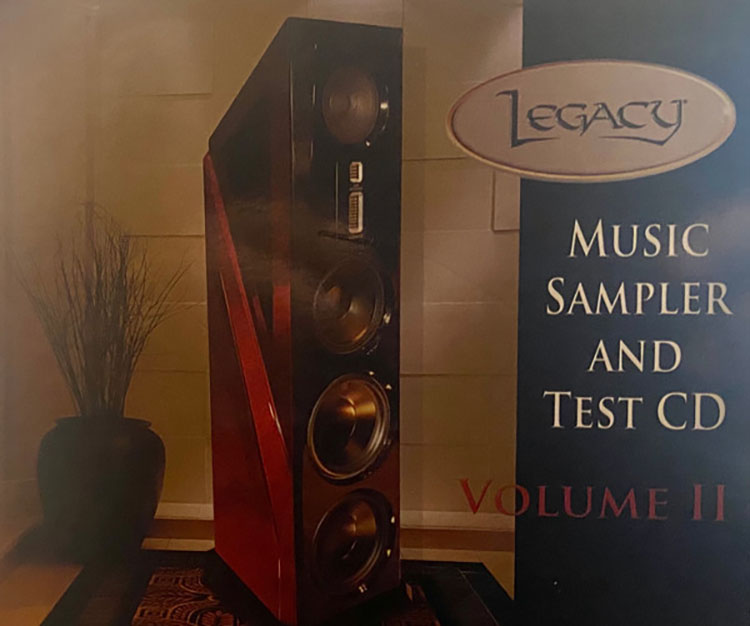
Legacy Audio Music Sampler and Test CD Volume II
Legacy Audio gave us a gem with this CD. There are a variety of test-style tracks towards the end of the disc that can help one with setting up any system. The rest of the CD is filled with music tracks that push an audio system with challenging tracks. Our listening tests centered on five selections: 1. ‘Novocaine’ by Amber Rubarth. Tracks 2 and 6 feature ‘Sparrow Dance’ and ‘Parasol Dance’ by The LA Percussion Quartet. Tracks 4 and 8 showcase James Darby with ‘Don’t Stop’ and ‘In the Brass.’
‘Novocaine’ starts with Rubarth plucking her acoustic guitar, then adding some percussion with frequent thwacks against the guitar body. This type of percussion adds a subtle level of bass that many systems merely catch as a ‘thump.’ It should be more elusive than that. It should be instant and add a tuneful, toe-tapping level of enjoyment to the music. The Michi Q5 nailed this as well. I have heard this song numerous times over several years on several systems, and the Q5 dropped off those last remaining veils between listener and music. When Rubarth started singing, one was pushed back a bit because she was suddenly there. Her voice was floating out of a totally black background. Following her lyrics was both easy and fun. This Q5 anchored system can handle female vocals with total believability.
‘Sparrow Dance’ and ‘Parasol Dance’ both feature dynamics from a wide spread of wood on wood to rapid fire xylophone hits. A frequent discussion within the audio community is the superiority of vinyl records with turntables on one side and CDs in proper CD players on the other side. Both sides make great points, and we are not going to settle that argument here. What we can settle is that the Michi Q5 was hitting the wood-on-wood portions on both tracks in a way that each note was pitch perfect with the upper range percussion from the xylophone. The Q5 was delivering the analog signal with that extra warmth that belies it was ever digital in the first place. The lightest touches come through with crystal clarity, only to have the macro-dynamics challenge the dynamic range of the system. The Q5 never flinched at these difficult tracks, but rather just kept smiling and delivering music as it was intended to be rendered.
Moving to ‘Don’t Stop’ and ‘In the Brass’ by James Darby features bass in both the guitar work, but also with the guttural noises being prominent. It feels as if a rather large beast is intimidating the listener. The brass and drum sections ebb back and forth with huge dynamic swings, and the Michi Q5 was again exceeding expectations. Biting brass melded with an intense bass line in a manner that showed off the skills of the eight-channel DAC combined with a massive transport system. If these two tracks don’t make you move a little, see a doctor.
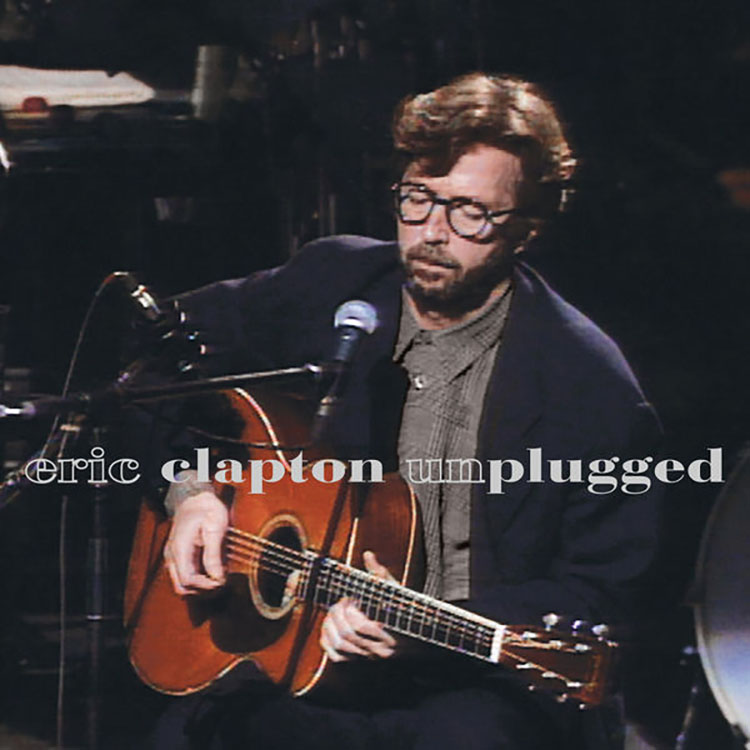
Eric Clapton, “Unplugged”
Eric Clapton performing live on acoustic guitar: what else could one want? The concert opens with ‘Signe,’ featuring Clapton playing along with some castanets in the background. It’s a simple song played to warm up the crowd a bit, yet it again showed off the talents of this CD player and DAC. It immediately felt ‘closer to live’ than in past listening sessions. ‘Before You Accuse Me’ adds that extra oomph to acoustic guitar with frequent body hits to the instrument that require a deft touch to bring to one’s ears with that elusive ‘tunefulness’ we all love to experience. The Q5 does so with aplomb. Keeping one’s feet still during this blues gem isn’t an option.
‘Hey Hey’ brings more of the same, with an even more upbeat cadence to the tune. Clapton’s voice is rich and nuanced, without a hint of boom to it. Then we are treated to ‘Tears in Heaven,’ a love song for the all-too-sad loss of his son. Both his guitar and singing bring out the sheer pain with which he has been living. It’s a testament to Eric Clapton to be able to perform this with such emotion while holding it together. ‘Layla’ is more of the same from Clapton and the Q5. The slow, toe-tapping bass line he brings into his guitar melds with his voice and the background singers in a blues-filled rendition of this rock classic.
The Michi Q5 is a sensational music maker. How does the DAC affect the movie experience?

Avengers: End Game (Disney+ Streaming)
‘End Game’ is a three-hour festival of sonic treats (along with being a rousing ending to the Marvel series that started with Iron Man in 2008) and was selected for this review because it checks so many boxes. Its orchestral music selections throughout the movie, the dialog, special effects, and bass tracks are a challenge to any system, especially the two-channel system being reviewed here. The DAC portion of the Michi Q5 takes center stage with a Toslink Optical cable accepting the digital signal from our 75- inch Samsung 4K TV. The Q5 has one job here: Convert the digital signal to analog and feed the rest of the system. How will a movie mix of multiple channels fare when condensed into a stereo signal, feeding the Michi P5, McIntosh MC303, and the Diptyque 140 Mark II planar speakers?
We open with Iron Man / Tony Stark on the derelict spaceship deep in space. Stark is playing the ‘triangle paper field goal game’ with Nebula as they pass the time until their oxygen runs out. The conversation between the two is rife with echoes and reverb from the large confines of the ship, and the detail which the Q5 DAC exacts from the stream is spot on. The two channels bring a sense of realism and space that expands far outside the speakers. My bride was certain that I was playing a trick on her by putting rear speakers into the system. She was mistaken in this belief.
The music score consistently added to each scene. The violin section was getting the most work, and it was first-rate in every scene, bringing up the emotional level with perfect spacing and timing. The natural sound of the bows on strings had loads of gravitas, and often the deep woodwind section would add to the performance.
Bass effects were much deeper and more powerful than one expected, even through a planar speaker known for its bass. This ability of the Michi Q5’s DAC to deliver such potent bass is a testament to the over-built power supply and good old-fashioned high current capability. All that weight is the anchor of this performance. Rocket engines firing felt ominous in their authority, and explosions were tight and punchy. The Michi Q5 continued to demonstrate an ability to extract every possible nuance from every signal.
No discussion of ‘End Game’ would be complete without an assessment of the grandeur of that final, epic battle between the Avengers’ army and the Thanos invasion force. This scene starts in almost silence as Captain America realizes he stands alone against an immense army of unfathomable strength. Then there is a whisper behind him: “On your left.” And Black Panther (along with his two lady warriors) enters through a ring portal. Soon, dozens of portals open, and an equally impressive army of heroes enters the scene.
While all of this is happening, the music score continues, and the sheer emotion of the scene (in theaters, people were standing and cheering) requires a lot from a system. The DAC in the Q5 did its thing again. The whisper when Captain America says ‘assemble’ was crystal clear, while the immediate crescendo of music, firepower, and rushing armies brought a wall of audio power that was nothing short of virile. Percussive bass is abundant, and dialog is omnipresent through the mayhem. Yet the Michi Q5 DAC never quit. There was never a hint of any detail being lost. In five weeks of auditioning by this point, there was never a time that I wished for more or thought something could be presented with more accuracy, emotion, or extension at either frequency extreme.
Secrets Sponsor
Some audiophiles might overlook the Michie Q5 DAC / Transport because it’s only $6,999, not $25,000. That would be a mistake of great proportions.
- Large LCD Screen on the front panel.
- Simple remote.
- Incredibly powerful bass.
- Detail galore.
- Can be both the perfect CD player and a separate DAC in one chassis.
- Build quality to last for decades.
- Deep black background provides a low noise level.
- Balanced XLR output.
- Streaming capability.
- Ability to play SACDs.
The Michi Q5 CD Transport / DAC is not inexpensive at $6,999. Yet one of its biggest challenges is that it can be a part of any system, regardless of the price, and some may overlook it because it isn’t $25,000. This would be a shame, because as a central hub for CDs, converting streaming music’s digital signal to analog and doing the same for cinema and TV, it is a world-class component at a very compelling price point.
Having owned a Michi P5 pre-amplifier and S5 power amplifier for several years, I was already familiar with the sound quality of Michi’s components. The S5 power amplifier has been proven to be conservatively spec’d at 500 WPC @ 8 ohms / 800 WPC @ 4 ohms, with lab tests consistently showing results about 25 percent higher in terms of output. Based on this experience, I had high expectations for the Michi Q5. It not only met those expectations, but it also completely trounced them. The bass from the big Q5 is deep and powerful while remaining tuneful. The sound stage is expansive in a 3D sense. The highs seem endless with no harshness. In several weeks of testing, I could not hear a fault with this unit. For $6,999, it is a bargain in today’s high-end world. The CD is said to be making a comeback. As someone who owns 2000 of them, I say wonderful! And the Michi Q5 is the answer to the question a lot of CD fans have: What can I do to get the most out of my CDs with a reasonably priced component? If you want to breathe new life into your collection, head to your Michi dealer. He or she has your answer.
The Michi Q5 CD Player/DAC is a truly exceptional component. Full stop. For my own system, I am going to be purchasing the review sample. I believe this is called ‘putting your money where your mouth is.’


